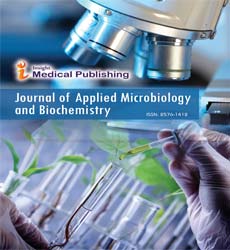ISSN : ISSN: 2576-1412
Journal of Applied Microbiology and Biochemistry
Harnessing Microbial Metabolism for Sustainable Biomanufacturing and Green Biotechnology
*Corresponding author:
Wijffels Marlon
Department of Biochemistry and Molecular Biology, Max Planck Institute for Terrestrial Microbiology, Marburg, Germany
E-mail: wijffelsarlon@aer.de
Received date: January 01, 2025, Manuscript No. ipjamb-25-20449; Editor assigned date: January 03, 2025, PreQC No. ipjamb-25-20449 (PQ); Reviewed date: January 16, 2025, QC No. ipjamb-25-20449; Revised date: January 21, 2025, Manuscript No. ipjamb-25-20449 (R); Published date: January 29, 2025, DOI: 10.36648/2576-1412.9.1.262
Citation: Marlon W (2025) Harnessing Microbial Metabolism for Sustainable Biomanufacturing and Green Biotechnology. J Appl Microbiol Biochem Vol. 9 No.1: 262.
Introduction
The search for sustainable solutions to pressing global challenges such as climate change, resource depletion, and environmental degradation has brought microbial biotechnology into sharp focus. Microorganisms, through their diverse metabolic pathways, represent natureâ??s most versatile and efficient biocatalysts. From converting waste into biofuels, producing bioplastics from renewable feedstocks, and synthesizing high-value pharmaceuticals, to detoxifying polluted environments, microbial metabolism is at the heart of modern biomanufacturing and green biotechnology. Unlike traditional chemical manufacturing processes, which often rely on finite fossil resources and generate significant toxic byproducts, microbial-driven systems promise lower carbon footprints, improved energy efficiency, and compatibility with circular economy principles. The integration of microbial metabolism with synthetic biology, metabolic engineering, and systems biology now offers unprecedented opportunities to create scalable, eco-friendly production pipelines that can reduce humanityâ??s dependence on unsustainable industrial practices [1].
Description
The foundation of microbial metabolism lies in the extraordinary diversity of biochemical reactions carried out by bacteria, fungi, archaea. Each microbial species has evolved unique enzymatic machinery to adapt to its ecological niche, often thriving under extreme conditions where conventional catalysts fail. These natural capabilities provide a platform for developing robust industrial applications. Instance, microbes can metabolize sugars, cellulose, lignin, lipids, and even gases such as methane and carbon dioxide, converting them into a spectrum of value-added products. In sustainable bio manufacturing, these metabolic pathways can be redirected or enhanced using genetic engineering and synthetic biology tools. Similarly, extremophiles microbes, capable of functioning under high temperature, acidity, are increasingly harnessed for industrial applications requiring stability under harsh conditions [2].
One of the most significant applications of microbial metabolism is in the production of biofuels, a key driver of the green energy revolution. Traditional fossil fuels are unsustainable and contribute heavily to greenhouse gas emissions. Microbial fermentation offers an eco-friendly alternative, using agricultural residues, lignocellulosic biomass, or food waste as feedstocks. Ethanol production from yeast fermentation is well established, but second-generation biofuels such as biobutanol, biodiesel, and hydrogen are gaining attention due to their higher energy content and compatibility with existing infrastructure. Cyanobacteria and microalgae, capable of directly converting sunlight and COâ?? into lipids or hydrogen, represent promising biofuel producers for the future. By integrating microbial biofuel production with waste valorization and carbon capture, industries can move toward closed-loop systems that minimize emissions while generating renewable energy [3].
Beyond energy, microbial metabolism plays a pivotal role in developing bioplastics, a critical step toward reducing the environmental burden of petroleum-derived plastics. Polyhydroxyalkanoates, for example, are biodegradable polymers naturally synthesized by bacteria under nutrient-limited conditions. With properties comparable to conventional plastics, PHAs are increasingly being explored as replacements in packaging, agriculture, and biomedical materials. Similarly, lactic acid, produced by lactic acid bacteria, serves as a precursor for polylactic acid, another biodegradable plastic with wide commercial applications. The challenge lies in scaling production economically, but metabolic engineering and adaptive laboratory evolution have significantly improved microbial yields, making bioplastic production more viable [4].
Pharmaceuticals and therapeutics also rely heavily on microbial metabolism. Natural product biosynthesis, driven by complex microbial enzymatic machinery, has historically provided antibiotics, anticancer agents, and immunosuppressants. Advances in genomics and bioinformatics have revealed a vast reservoir of â??crypticâ? biosynthetic gene clusters within microbial genomes, many of which remain unexploited [5].
Conclusion
The harnessing of microbial metabolism for sustainable biomanufacturing and green biotechnology marks a paradigm shift in how humanity approaches production, energy, healthcare, and environmental stewardship. Microorganisms, with their vast metabolic repertoire, are natureâ??s most efficient chemists, capable of converting diverse feedstocks into fuels, chemicals, plastics, and medicines with minimal ecological impact. Advances in metabolic engineering, synthetic biology, and computational modeling have opened new frontiers, enabling tailored design of microbial systems for industrial scalability. While challenges remain in cost, scale, and regulation, the integration of microbial biotechnology with digital tools, waste valorization, and circular economy principles promises a resilient and sustainable future. As the global community confronts climate change and resource depletion, microbial metabolism stands as both a scientific frontier and a practical solutionâ??turning the invisible power of microbes into visible benefits for society, industry, and the environment.
Acknowledgement
None.
Conflict of Interest
None.
References
- Li Y, Han D, Hu G, Sommerfeld M, Hu Q (2010). Inhibition of starch synthesis results in overproduction of lipids in Chlamydomonas reinhardtii. Biotechnol Bioeng 107: 258-268.
- Ruffing AM, Jones HD (2012). Physiological effects of free fatty acid production in genetically engineered Synechococcus elongatus PCC 7942. Biotechnol Bioeng 109: 2190-2199.
Google Scholar Cross Ref Indexed at
- Hitchcock A, Hunter CN, Sobotka R, Komenda J, Dann M, et al. (2022). Redesigning the photosynthetic light reactions to enhance photosynthesis–the PhotoRedesign consortium. Plant J 109: 23-34.
- Baltz A, Dang KV, Beyly A, Auroy P, Richaud P, et al. (2014). Plastidial expression of type II NAD (P) H dehydrogenase increases the reducing state of plastoquinones and hydrogen photoproduction rate by the indirect pathway in Chlamydomonas reinhardtii. Plant Physiol 165: 1344-1352.
Google Scholar Cross Ref Indexed at
- Llamas A, Leon-Miranda E, Tejada-Jimenez M (2023). Microalgal and nitrogen-fixing bacterial consortia: From interaction to biotechnological potential. Plants 12: 2476.
Open Access Journals
- Aquaculture & Veterinary Science
- Chemistry & Chemical Sciences
- Clinical Sciences
- Engineering
- General Science
- Genetics & Molecular Biology
- Health Care & Nursing
- Immunology & Microbiology
- Materials Science
- Mathematics & Physics
- Medical Sciences
- Neurology & Psychiatry
- Oncology & Cancer Science
- Pharmaceutical Sciences
